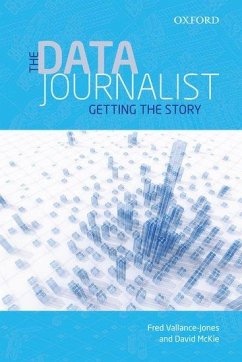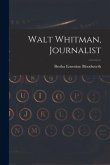- Broschiertes Buch
- Merkliste
- Auf die Merkliste
- Bewerten Bewerten
- Teilen
- Produkt teilen
- Produkterinnerung
- Produkterinnerung
The Data Journalist: Getting the Story is the definitive introduction to using data and technology in reporting for both journalism students and working practitioners. It covers both the basics and more advanced techniques, discussing what data is, where it is stored, and how it can be used to create engaging journalism.
Andere Kunden interessierten sich auch für
![He Wrote for Us; the Story of Bill Bennett, Pioneer Socialist Journalist He Wrote for Us; the Story of Bill Bennett, Pioneer Socialist Journalist]() Thomas Alexander McEwenHe Wrote for Us; the Story of Bill Bennett, Pioneer Socialist Journalist19,99 €
Thomas Alexander McEwenHe Wrote for Us; the Story of Bill Bennett, Pioneer Socialist Journalist19,99 €![Why Journalism - Real news in the age of lies Why Journalism - Real news in the age of lies]() Erik FichteliusWhy Journalism - Real news in the age of lies27,00 €
Erik FichteliusWhy Journalism - Real news in the age of lies27,00 €![Trend oder Zukunft: Daten als zentraler Gegenstand der journalistischen Berichterstattung. Trend oder Zukunft: Daten als zentraler Gegenstand der journalistischen Berichterstattung.]() Blasius KawalkowskiTrend oder Zukunft: Daten als zentraler Gegenstand der journalistischen Berichterstattung.39,99 €
Blasius KawalkowskiTrend oder Zukunft: Daten als zentraler Gegenstand der journalistischen Berichterstattung.39,99 €![Dyslexia and the Journalist Dyslexia and the Journalist]() Tony SilviaDyslexia and the Journalist43,99 €
Tony SilviaDyslexia and the Journalist43,99 €![The Human Journalist The Human Journalist]() Jim WillisThe Human Journalist39,99 €
Jim WillisThe Human Journalist39,99 €![Walt Whitman, Journalist Walt Whitman, Journalist]() Bertha Ernestine BloodworthWalt Whitman, Journalist16,99 €
Bertha Ernestine BloodworthWalt Whitman, Journalist16,99 €![Journalist Safety and Self-Censorship Journalist Safety and Self-Censorship]() Journalist Safety and Self-Censorship54,99 €
Journalist Safety and Self-Censorship54,99 €-
-
-
The Data Journalist: Getting the Story is the definitive introduction to using data and technology in reporting for both journalism students and working practitioners. It covers both the basics and more advanced techniques, discussing what data is, where it is stored, and how it can be used to create engaging journalism.
Hinweis: Dieser Artikel kann nur an eine deutsche Lieferadresse ausgeliefert werden.
Hinweis: Dieser Artikel kann nur an eine deutsche Lieferadresse ausgeliefert werden.
Produktdetails
- Produktdetails
- Verlag: Hurst & Co.
- Seitenzahl: 320
- Erscheinungstermin: 1. März 2017
- Englisch
- Abmessung: 226mm x 150mm x 18mm
- Gewicht: 386g
- ISBN-13: 9780199020065
- ISBN-10: 019902006X
- Artikelnr.: 47813058
- Herstellerkennzeichnung
- Libri GmbH
- Europaallee 1
- 36244 Bad Hersfeld
- gpsr@libri.de
- Verlag: Hurst & Co.
- Seitenzahl: 320
- Erscheinungstermin: 1. März 2017
- Englisch
- Abmessung: 226mm x 150mm x 18mm
- Gewicht: 386g
- ISBN-13: 9780199020065
- ISBN-10: 019902006X
- Artikelnr.: 47813058
- Herstellerkennzeichnung
- Libri GmbH
- Europaallee 1
- 36244 Bad Hersfeld
- gpsr@libri.de
Fred Vallance-Jones, Associate Professor, University of King's College, David McKie, Instructor, School of Journalism and Communication, Carleton University
Foreword
Acknowledgements
Aurthor Biographies
Part I Introduction
1: Introduction
The Origins of Data Journalism
Technology: The Tools of Data and How Journalists Use Them
2: Online and Open Data
What You Will Learn
Principles
The History of Open Government and Open Data
What Kind of Data Can You Get?
Chicago's Crime Database
Toronto Payment Card Data
Road Accidents in the United Kingdom
Vancouver Food Vendors
Mine Accidents
Data Quality Concerns
Steps to Take When Working With Any Dataset
Study Questions and Exercises
3: When Data Is Not Conveniently Available
What You Will Learn
Informing Yourself
Asking
Negotiating for Data
Demanding
Making an Effective Request for Data
After You Make the Request
The Answer
Study Questions and Exercises
4: Spreadsheets: The Basic Tool
What You Will Learn
Introduction
So What Exactly Is a Spreadsheet?
Fundamentals of Spreadsheets
How Journalists Use Spreadsheets
Getting Data into a Spreadsheet
Getting to Work
Simple Analysis
Filtering
Doing the Math
- Functions Big and Small
- Calculating Percentages
- Calculating Rates
Dealing with Errors
Working with Dates
Concatenation
Summarizing Information with Pivot Tables
Logical Functions and IF Statements
Using Paste Special to Convert Formulas to Values
Chronologies
Conclusion
Study Questions and Exercises
5: Working with Databases
What You Will Learn
Working with a Database
Building Relationships
Database Programs
Making Tables and Adding Data
The Main Course: Querying your Data
- The Language of Queries
- Writing Math Queries
- The GROUP BY Clause
- The HAVING Clause
- Aliases
- Joining Tables
- Some Notes about Joining
More Advanced Queries
- Outer Joins
- Union Queries
- Subqueries
- Using Calculated Fields and String Functions
- Creating Views (MySQL)
- Improving Query Performances by Adding Indexes
- Queries to Alter your Data
- Exporting Query Results
Building your own Database
Some Final Thoughts
Study Questions and Exercises
6: Introduction to Maps in Journalism
What You Will Learn
Maps Are Not Reality, but Representations of Reality
Web Mapping Services
Getting your Data onto a Web Map
Data Not Already in a Map Format
Your Data Is Ready, How To Use It?
What Kinds of Maps Can You Make?
- Boundary Maps
Some Important Design Principles
- A Choice of Styles
- Choosing Appropriate Colours
- Setting Breakpoints
Conclusion
Study Questions and Exercises
7: Working with GIS Programs
What You Will Learn
The Inside Story
Ellipsoids and Datums: Modelling the World
Projections
Four Properties: Direction, Area, Shape, and Distance
How Datums and Projections are Incorporated in a GIS
Basics of a GIS
How Spatial Data Is Structured
- Metadata
- Geometrics
- Attributes
- Working with Layers
How Journalists Use GIS Programs
- Joining Non-Geographic Data with Geographic Data
- Selecting Features that Meet Certain Criteria
- Buffering
- Joining Data Based on Geographical Location
- Making a Chloropleth Map
- Geocoding
Common Problems and Solutions
- Projecting and Re-Projecting a Map Layer
- Converting File Formats
- Simplifying Polygons
- Combining Layers into a Single Layer
- Combining Features within a Single Layer
Special Considerations Relative to Coordinate Systems
- Using a Map Layer that has Only a Geographic Coordinate System
- Using Maps Based on Different Geographic Coordinate Systems
- Using an Inappropriate Projected Coordinate System
Conclusion
Study Questions and Exercises
Recommended Further Reading
8: Visualizing Data
What You Will Learn
A History of Visualization: From William Playfair to the Present Day
Choosing the Right Chart
- The Pie Chart
- A Bar Chart
- The Line Chart
How Journalists Use "Data Viz" Tools
- One Producer's View
Conclusion
Study Questions and Exercises
Part II Advanced Topics
9: Web Scraping
What You Will Learn
The Underpinnings of Scraping
Options for Scraping
First Steps, Thinking through your Scrape
Coding Basics
Getting Ready to Code
- Fetching the Page
- Scraping More than One Page
- More Complicated Scrapes
The Ethics of Web Scraping
APIs
Conclusion
Study Questions and Exericses
Additional Resources
10: Web Development
What You Will Learn
State of Developers in Newsrooms
Core Languages Used by Newsroom Developers: An Introduction to the Work Environment
- The Server-Side: Writing for your Own Machine
- The Client-Side: Writing for Everyone Else's Machine
Case Study: Using freeDive
Working with JavaScript Libraries such as jQuery and D3
Conclusion
Study Questions and Exercises
Additional Reading
11: Incorporating Data Journalism into Traditional Reporting
What You Will Learn
Why Data is Just the Beginning
Finding Outliers that Lead to Human Stories
Testing your Data in the Real World
Connecting Data Patterns with Real-Life Patterns
Building Powerful Interviews and Writing the Story
Conclusion
Study Questions and Exercises
Glossary
Credits
Index
Acknowledgements
Aurthor Biographies
Part I Introduction
1: Introduction
The Origins of Data Journalism
Technology: The Tools of Data and How Journalists Use Them
2: Online and Open Data
What You Will Learn
Principles
The History of Open Government and Open Data
What Kind of Data Can You Get?
Chicago's Crime Database
Toronto Payment Card Data
Road Accidents in the United Kingdom
Vancouver Food Vendors
Mine Accidents
Data Quality Concerns
Steps to Take When Working With Any Dataset
Study Questions and Exercises
3: When Data Is Not Conveniently Available
What You Will Learn
Informing Yourself
Asking
Negotiating for Data
Demanding
Making an Effective Request for Data
After You Make the Request
The Answer
Study Questions and Exercises
4: Spreadsheets: The Basic Tool
What You Will Learn
Introduction
So What Exactly Is a Spreadsheet?
Fundamentals of Spreadsheets
How Journalists Use Spreadsheets
Getting Data into a Spreadsheet
Getting to Work
Simple Analysis
Filtering
Doing the Math
- Functions Big and Small
- Calculating Percentages
- Calculating Rates
Dealing with Errors
Working with Dates
Concatenation
Summarizing Information with Pivot Tables
Logical Functions and IF Statements
Using Paste Special to Convert Formulas to Values
Chronologies
Conclusion
Study Questions and Exercises
5: Working with Databases
What You Will Learn
Working with a Database
Building Relationships
Database Programs
Making Tables and Adding Data
The Main Course: Querying your Data
- The Language of Queries
- Writing Math Queries
- The GROUP BY Clause
- The HAVING Clause
- Aliases
- Joining Tables
- Some Notes about Joining
More Advanced Queries
- Outer Joins
- Union Queries
- Subqueries
- Using Calculated Fields and String Functions
- Creating Views (MySQL)
- Improving Query Performances by Adding Indexes
- Queries to Alter your Data
- Exporting Query Results
Building your own Database
Some Final Thoughts
Study Questions and Exercises
6: Introduction to Maps in Journalism
What You Will Learn
Maps Are Not Reality, but Representations of Reality
Web Mapping Services
Getting your Data onto a Web Map
Data Not Already in a Map Format
Your Data Is Ready, How To Use It?
What Kinds of Maps Can You Make?
- Boundary Maps
Some Important Design Principles
- A Choice of Styles
- Choosing Appropriate Colours
- Setting Breakpoints
Conclusion
Study Questions and Exercises
7: Working with GIS Programs
What You Will Learn
The Inside Story
Ellipsoids and Datums: Modelling the World
Projections
Four Properties: Direction, Area, Shape, and Distance
How Datums and Projections are Incorporated in a GIS
Basics of a GIS
How Spatial Data Is Structured
- Metadata
- Geometrics
- Attributes
- Working with Layers
How Journalists Use GIS Programs
- Joining Non-Geographic Data with Geographic Data
- Selecting Features that Meet Certain Criteria
- Buffering
- Joining Data Based on Geographical Location
- Making a Chloropleth Map
- Geocoding
Common Problems and Solutions
- Projecting and Re-Projecting a Map Layer
- Converting File Formats
- Simplifying Polygons
- Combining Layers into a Single Layer
- Combining Features within a Single Layer
Special Considerations Relative to Coordinate Systems
- Using a Map Layer that has Only a Geographic Coordinate System
- Using Maps Based on Different Geographic Coordinate Systems
- Using an Inappropriate Projected Coordinate System
Conclusion
Study Questions and Exercises
Recommended Further Reading
8: Visualizing Data
What You Will Learn
A History of Visualization: From William Playfair to the Present Day
Choosing the Right Chart
- The Pie Chart
- A Bar Chart
- The Line Chart
How Journalists Use "Data Viz" Tools
- One Producer's View
Conclusion
Study Questions and Exercises
Part II Advanced Topics
9: Web Scraping
What You Will Learn
The Underpinnings of Scraping
Options for Scraping
First Steps, Thinking through your Scrape
Coding Basics
Getting Ready to Code
- Fetching the Page
- Scraping More than One Page
- More Complicated Scrapes
The Ethics of Web Scraping
APIs
Conclusion
Study Questions and Exericses
Additional Resources
10: Web Development
What You Will Learn
State of Developers in Newsrooms
Core Languages Used by Newsroom Developers: An Introduction to the Work Environment
- The Server-Side: Writing for your Own Machine
- The Client-Side: Writing for Everyone Else's Machine
Case Study: Using freeDive
Working with JavaScript Libraries such as jQuery and D3
Conclusion
Study Questions and Exercises
Additional Reading
11: Incorporating Data Journalism into Traditional Reporting
What You Will Learn
Why Data is Just the Beginning
Finding Outliers that Lead to Human Stories
Testing your Data in the Real World
Connecting Data Patterns with Real-Life Patterns
Building Powerful Interviews and Writing the Story
Conclusion
Study Questions and Exercises
Glossary
Credits
Index
Foreword
Acknowledgements
Aurthor Biographies
Part I Introduction
1: Introduction
The Origins of Data Journalism
Technology: The Tools of Data and How Journalists Use Them
2: Online and Open Data
What You Will Learn
Principles
The History of Open Government and Open Data
What Kind of Data Can You Get?
Chicago's Crime Database
Toronto Payment Card Data
Road Accidents in the United Kingdom
Vancouver Food Vendors
Mine Accidents
Data Quality Concerns
Steps to Take When Working With Any Dataset
Study Questions and Exercises
3: When Data Is Not Conveniently Available
What You Will Learn
Informing Yourself
Asking
Negotiating for Data
Demanding
Making an Effective Request for Data
After You Make the Request
The Answer
Study Questions and Exercises
4: Spreadsheets: The Basic Tool
What You Will Learn
Introduction
So What Exactly Is a Spreadsheet?
Fundamentals of Spreadsheets
How Journalists Use Spreadsheets
Getting Data into a Spreadsheet
Getting to Work
Simple Analysis
Filtering
Doing the Math
- Functions Big and Small
- Calculating Percentages
- Calculating Rates
Dealing with Errors
Working with Dates
Concatenation
Summarizing Information with Pivot Tables
Logical Functions and IF Statements
Using Paste Special to Convert Formulas to Values
Chronologies
Conclusion
Study Questions and Exercises
5: Working with Databases
What You Will Learn
Working with a Database
Building Relationships
Database Programs
Making Tables and Adding Data
The Main Course: Querying your Data
- The Language of Queries
- Writing Math Queries
- The GROUP BY Clause
- The HAVING Clause
- Aliases
- Joining Tables
- Some Notes about Joining
More Advanced Queries
- Outer Joins
- Union Queries
- Subqueries
- Using Calculated Fields and String Functions
- Creating Views (MySQL)
- Improving Query Performances by Adding Indexes
- Queries to Alter your Data
- Exporting Query Results
Building your own Database
Some Final Thoughts
Study Questions and Exercises
6: Introduction to Maps in Journalism
What You Will Learn
Maps Are Not Reality, but Representations of Reality
Web Mapping Services
Getting your Data onto a Web Map
Data Not Already in a Map Format
Your Data Is Ready, How To Use It?
What Kinds of Maps Can You Make?
- Boundary Maps
Some Important Design Principles
- A Choice of Styles
- Choosing Appropriate Colours
- Setting Breakpoints
Conclusion
Study Questions and Exercises
7: Working with GIS Programs
What You Will Learn
The Inside Story
Ellipsoids and Datums: Modelling the World
Projections
Four Properties: Direction, Area, Shape, and Distance
How Datums and Projections are Incorporated in a GIS
Basics of a GIS
How Spatial Data Is Structured
- Metadata
- Geometrics
- Attributes
- Working with Layers
How Journalists Use GIS Programs
- Joining Non-Geographic Data with Geographic Data
- Selecting Features that Meet Certain Criteria
- Buffering
- Joining Data Based on Geographical Location
- Making a Chloropleth Map
- Geocoding
Common Problems and Solutions
- Projecting and Re-Projecting a Map Layer
- Converting File Formats
- Simplifying Polygons
- Combining Layers into a Single Layer
- Combining Features within a Single Layer
Special Considerations Relative to Coordinate Systems
- Using a Map Layer that has Only a Geographic Coordinate System
- Using Maps Based on Different Geographic Coordinate Systems
- Using an Inappropriate Projected Coordinate System
Conclusion
Study Questions and Exercises
Recommended Further Reading
8: Visualizing Data
What You Will Learn
A History of Visualization: From William Playfair to the Present Day
Choosing the Right Chart
- The Pie Chart
- A Bar Chart
- The Line Chart
How Journalists Use "Data Viz" Tools
- One Producer's View
Conclusion
Study Questions and Exercises
Part II Advanced Topics
9: Web Scraping
What You Will Learn
The Underpinnings of Scraping
Options for Scraping
First Steps, Thinking through your Scrape
Coding Basics
Getting Ready to Code
- Fetching the Page
- Scraping More than One Page
- More Complicated Scrapes
The Ethics of Web Scraping
APIs
Conclusion
Study Questions and Exericses
Additional Resources
10: Web Development
What You Will Learn
State of Developers in Newsrooms
Core Languages Used by Newsroom Developers: An Introduction to the Work Environment
- The Server-Side: Writing for your Own Machine
- The Client-Side: Writing for Everyone Else's Machine
Case Study: Using freeDive
Working with JavaScript Libraries such as jQuery and D3
Conclusion
Study Questions and Exercises
Additional Reading
11: Incorporating Data Journalism into Traditional Reporting
What You Will Learn
Why Data is Just the Beginning
Finding Outliers that Lead to Human Stories
Testing your Data in the Real World
Connecting Data Patterns with Real-Life Patterns
Building Powerful Interviews and Writing the Story
Conclusion
Study Questions and Exercises
Glossary
Credits
Index
Acknowledgements
Aurthor Biographies
Part I Introduction
1: Introduction
The Origins of Data Journalism
Technology: The Tools of Data and How Journalists Use Them
2: Online and Open Data
What You Will Learn
Principles
The History of Open Government and Open Data
What Kind of Data Can You Get?
Chicago's Crime Database
Toronto Payment Card Data
Road Accidents in the United Kingdom
Vancouver Food Vendors
Mine Accidents
Data Quality Concerns
Steps to Take When Working With Any Dataset
Study Questions and Exercises
3: When Data Is Not Conveniently Available
What You Will Learn
Informing Yourself
Asking
Negotiating for Data
Demanding
Making an Effective Request for Data
After You Make the Request
The Answer
Study Questions and Exercises
4: Spreadsheets: The Basic Tool
What You Will Learn
Introduction
So What Exactly Is a Spreadsheet?
Fundamentals of Spreadsheets
How Journalists Use Spreadsheets
Getting Data into a Spreadsheet
Getting to Work
Simple Analysis
Filtering
Doing the Math
- Functions Big and Small
- Calculating Percentages
- Calculating Rates
Dealing with Errors
Working with Dates
Concatenation
Summarizing Information with Pivot Tables
Logical Functions and IF Statements
Using Paste Special to Convert Formulas to Values
Chronologies
Conclusion
Study Questions and Exercises
5: Working with Databases
What You Will Learn
Working with a Database
Building Relationships
Database Programs
Making Tables and Adding Data
The Main Course: Querying your Data
- The Language of Queries
- Writing Math Queries
- The GROUP BY Clause
- The HAVING Clause
- Aliases
- Joining Tables
- Some Notes about Joining
More Advanced Queries
- Outer Joins
- Union Queries
- Subqueries
- Using Calculated Fields and String Functions
- Creating Views (MySQL)
- Improving Query Performances by Adding Indexes
- Queries to Alter your Data
- Exporting Query Results
Building your own Database
Some Final Thoughts
Study Questions and Exercises
6: Introduction to Maps in Journalism
What You Will Learn
Maps Are Not Reality, but Representations of Reality
Web Mapping Services
Getting your Data onto a Web Map
Data Not Already in a Map Format
Your Data Is Ready, How To Use It?
What Kinds of Maps Can You Make?
- Boundary Maps
Some Important Design Principles
- A Choice of Styles
- Choosing Appropriate Colours
- Setting Breakpoints
Conclusion
Study Questions and Exercises
7: Working with GIS Programs
What You Will Learn
The Inside Story
Ellipsoids and Datums: Modelling the World
Projections
Four Properties: Direction, Area, Shape, and Distance
How Datums and Projections are Incorporated in a GIS
Basics of a GIS
How Spatial Data Is Structured
- Metadata
- Geometrics
- Attributes
- Working with Layers
How Journalists Use GIS Programs
- Joining Non-Geographic Data with Geographic Data
- Selecting Features that Meet Certain Criteria
- Buffering
- Joining Data Based on Geographical Location
- Making a Chloropleth Map
- Geocoding
Common Problems and Solutions
- Projecting and Re-Projecting a Map Layer
- Converting File Formats
- Simplifying Polygons
- Combining Layers into a Single Layer
- Combining Features within a Single Layer
Special Considerations Relative to Coordinate Systems
- Using a Map Layer that has Only a Geographic Coordinate System
- Using Maps Based on Different Geographic Coordinate Systems
- Using an Inappropriate Projected Coordinate System
Conclusion
Study Questions and Exercises
Recommended Further Reading
8: Visualizing Data
What You Will Learn
A History of Visualization: From William Playfair to the Present Day
Choosing the Right Chart
- The Pie Chart
- A Bar Chart
- The Line Chart
How Journalists Use "Data Viz" Tools
- One Producer's View
Conclusion
Study Questions and Exercises
Part II Advanced Topics
9: Web Scraping
What You Will Learn
The Underpinnings of Scraping
Options for Scraping
First Steps, Thinking through your Scrape
Coding Basics
Getting Ready to Code
- Fetching the Page
- Scraping More than One Page
- More Complicated Scrapes
The Ethics of Web Scraping
APIs
Conclusion
Study Questions and Exericses
Additional Resources
10: Web Development
What You Will Learn
State of Developers in Newsrooms
Core Languages Used by Newsroom Developers: An Introduction to the Work Environment
- The Server-Side: Writing for your Own Machine
- The Client-Side: Writing for Everyone Else's Machine
Case Study: Using freeDive
Working with JavaScript Libraries such as jQuery and D3
Conclusion
Study Questions and Exercises
Additional Reading
11: Incorporating Data Journalism into Traditional Reporting
What You Will Learn
Why Data is Just the Beginning
Finding Outliers that Lead to Human Stories
Testing your Data in the Real World
Connecting Data Patterns with Real-Life Patterns
Building Powerful Interviews and Writing the Story
Conclusion
Study Questions and Exercises
Glossary
Credits
Index








